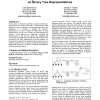Free Online Productivity Tools
i2Speak
i2Symbol
i2OCR
iTex2Img
iWeb2Print
iWeb2Shot
i2Type
iPdf2Split
iPdf2Merge
i2Bopomofo
i2Arabic
i2Style
i2Image
i2PDF
iLatex2Rtf
Sci2ools
GECCO
2006
Springer
2006
Springer
Estimating the destructiveness of crossover on binary tree representations
In some cases, evolutionary algorithms represent individuals as typical binary trees with n leaves and n-1 internal nodes. When designing a crossover operator for a particular representation and application, it is desirable to quantify the operator's destructiveness in order to estimate its effectiveness at using building blocks. For the case of binary tree representations, we present a novel approach for empirically estimating the destructiveness of any crossover operator by computing and summarizing the distribution of Robinson-Foulds distances from the parent to the entire neighborhood of possible children. We demonstrate the approach by quantifying the destructiveness of a popular tree-based crossover operator as applied to the problem of phylogenetic inferencing. We discuss the benefits and limitations of the destructiveness metric. Categories and Subject Descriptors E.1 [Data Structures]: Trees; I.2.8 [Problem Solving, Control Methods, and Search]: Graph and tree search str...
| Added | 23 Aug 2010 |
| Updated | 23 Aug 2010 |
| Type | Conference |
| Year | 2006 |
| Where | GECCO |
| Authors | Luke Sheneman, James A. Foster |
Comments (0)

